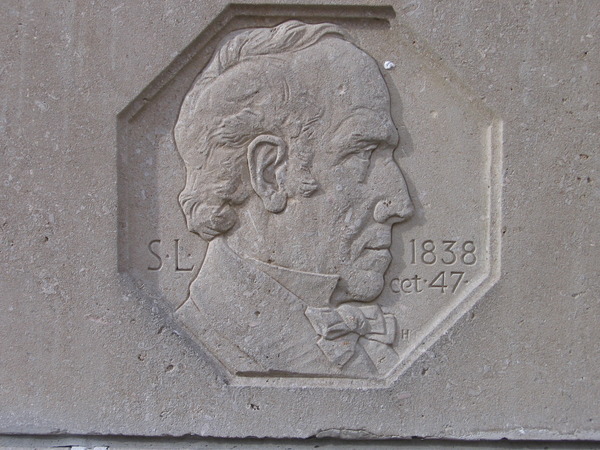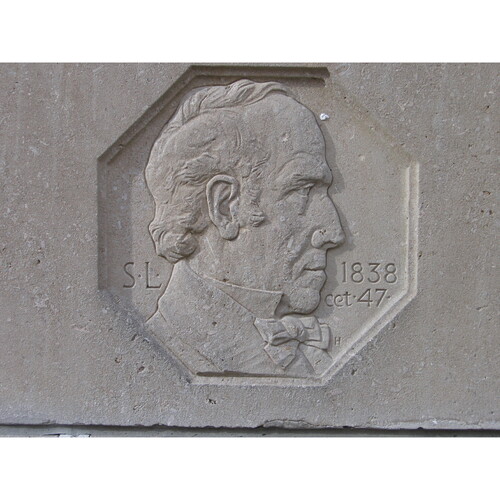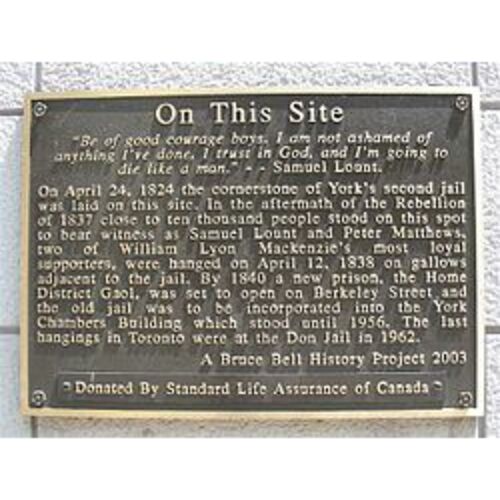
Source: Link
LOUNT, SAMUEL, blacksmith, surveyor’s assistant, businessman, politician, and rebel; b. 24 Sept. 1791 in Catawissa, Pa, eldest son of Gabriel Lount and Philadelphia Hughes; m. 1815 Elizabeth Soules, and they had seven children; hanged 12 April 1838 in Toronto.
Samuel Lount first came to Upper Canada when his father brought the family to Whitchurch Township in 1811, but he returned to Pennsylvania on business and spent the duration of the War of 1812 in the United States. Returning to Whitchurch in 1815, for the next three years Lount studied blacksmithing and he became an excellent craftsman. In the fall of 1818 he moved to Newmarket, where he kept a tavern for two years. During that time Lount, who was a skilled woodsman, assisted his brother George in the surveying of West Gwillimbury, Tecumseth, and Innisfil townships. He also explored the Nottawasaga River for the government in preparation for settlement.
Lount next lived in Whitchurch for about a year and a half, and then moved to the Holland Landing area. He was primarily a blacksmith, helping to build the first steamboat on Lake Simcoe, the Sir John Colborne, but he also kept a store in partnership with George for several years, and during the last two years of his life he was a farmer. An extremely generous man, Lount was sought out by many who immigrated to the Lake Simcoe region. He provided advice and assistance without thought of compensation and became one of the most highly respected settlers in the area. This stature led to offers of public office and requests that he become a candidate for the House of Assembly, but Lount preferred to remain in the background. He turned down the position of registrar of lands for Simcoe County in favour of George, and when asked to run for the assembly in 1828 he declined and supported John Cawthra.
In 1834 Lount was persuaded to run for Simcoe County and was successful. With his strong concern for his fellow man, he gravitated to the reformers, and he became a friend and ally of William Lyon Mackenzie*. In the election of 1836 Lount was defeated by William Benjamin Robinson*, who was assisted by what the reformers felt were corrupt practices on the part of the provincial executive, and he became disillusioned with normal political processes. He thus participated in the political union movement of the summer and fall of 1837 which was designed to pressure the British government to effect reforms. In the fall Lount was one of the small number of locally prominent men whom Mackenzie approached with a scheme to replace the provincial government with one responsive to the needs of the people.
Lount eagerly agreed to the plan, which involved a march on Toronto on 7 December, because he was assured by Mackenzie that it could be accomplished without bloodshed and would have the approval of prominent supporters of the government. He used his popularity in the area south of Lake Simcoe to influence many others to join the march. When a message from Dr John Rolph* urged that the uprising be advanced to 4 December to forestall rumoured preparations by the government, Lount led one of the first parties to reach Montgomery’s Tavern, north of Toronto, the headquarters selected by Mackenzie.
Lount was at the centre of activity until the rebellion failed on the 7th. However, the deaths of a rebel and a loyalist on the first night gave him strong misgivings about the venture. Despite Mackenzie’s opposition, he attempted to get medical aid for the dying loyalist, Colonel Robert Moodie. On 5 December, Lount and David Gibson* stopped Mackenzie from burning Sheriff William Botsford Jarvis*’s house as he had burned the home of Dr Robert Charles Horne.
When loyalist forces dispersed the rebels on 7 December, Lount tried to flee to the United States. He and another man attempted to row across Lake Erie but were blown back and arrested as possible smugglers. Accused of treason, Lount pleaded guilty and petitioned for mercy. Despite supporting petitions bearing thousands of signatures, Lieutenant Governor Sir George Arthur* and the Executive Council decided that some examples had to be made and condemned him to death. Lount and Peter Matthews were executed on 12 April 1838 in the courtyard of the Toronto jail. The government then confiscated Lount’s small amount of property.
[One of the best sources of information on Lount’s life is a letter written by his wife Elizabeth. This appears in the Mackenzie–Lindsey papers, Mackenzie corr., at AO, MS 516; it is to William Lyon Mackenzie and is dated 12 April 1850, from Pontiac, Mich. Another excellent source is A. F. Hunter, A history of Simcoe County (2v., Barrie, Ont., 1909; repr. 2v. in 1, 1948). A small amount of biographical detail is also to be found in George Lount’s petition to the Executive Council, dated 2 Jan. 1840, in PAC, RG 1, E3, 46, file 38. Lount’s version of his role in the rebellion is contained in his petition in PAC, RG 5, A1: 107033–38, and his statement in RG 5, C1, 9, file 1209. For a broader discussion of Lount’s role and additional sources, see R. J. Stagg, “The Yonge Street rebellion of 1837: an examination of the social background and a re-assessment of the events” (phd thesis, Univ. of Toronto, 1976). r.j.s.]
Cite This Article
Ronald J. Stagg, “LOUNT, SAMUEL,” in Dictionary of Canadian Biography, vol. 7, University of Toronto/Université Laval, 2003–, accessed December 12, 2025, https://www.biographi.ca/en/bio/lount_samuel_7E.html.
The citation above shows the format for footnotes and endnotes according to the Chicago manual of style (16th edition). Information to be used in other citation formats:
| Permalink: | https://www.biographi.ca/en/bio/lount_samuel_7E.html |
| Author of Article: | Ronald J. Stagg |
| Title of Article: | LOUNT, SAMUEL |
| Publication Name: | Dictionary of Canadian Biography, vol. 7 |
| Publisher: | University of Toronto/Université Laval |
| Year of publication: | 1988 |
| Year of revision: | 1988 |
| Access Date: | December 12, 2025 |




